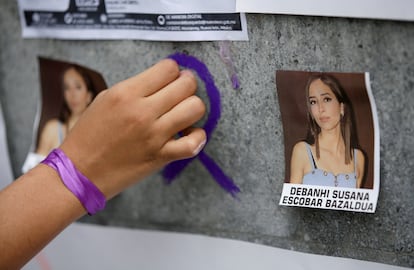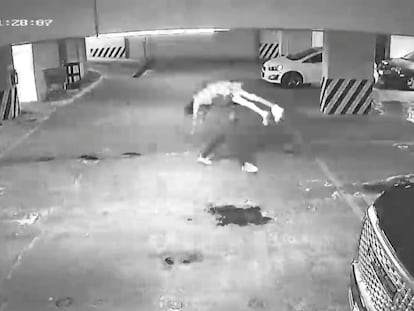Debanhi Escobar: a year of impunity in the case that became a rallying cry over femicides in Mexico
The 18-year-old disappeared in Monterrey and was found 13 days later in a motel cistern. There are still no arrests or any answers about who killed her, or why

It has been a year since Mario Escobar emerged from the Nueva Castilla motel, on the outskirts of Monterrey, in the early hours and approached the press, saying through tears: “My daughter is dead and I don’t know what to do.” With those words, Mario Escobar confirmed that the body that had been discovered inside an abandoned cistern was that of 18-year-old Debanhi Escobar, who had been the focus of a 13-day search involving her family, local residents and hundreds of police officers. The disappearance of the young woman sparked distress throughout Mexico and turned her into the country’s latest symbol in the battle against femicides. The Debanhi Escobar case, which has still produced no answers and no arrests, illustrates Mexico’s failure to achieve justice for murdered women.
“It has been 365 days since Debanhi was dumped in that motel; one year since that atrocity was committed against our daughter,” Mario Escobar told El PAÍS. He and his wife, Dolores Bazaldúa, have called for a demonstration this Friday in Monterrey, which will leave from the main square of the state capital and head to the Nuevo León Prosecutor’s Office. Ultimately, the march will arrive at the Nueva Castilla motel to observe a minute of silence. “There are still many unanswered questions; what we are looking for is justice and truth,” says Escobar.
Debanhi Escobar, the daughter of two teachers, was a law student law at the Autonomous University of Nuevo León and liked to dance. On April 8, she went to a party with a group of friends. Security cameras captured her entering and leaving a property in the municipality of Escobedo. On the first trip, she was accompanied by two friends and on the return trip, she was alone. The same driver took her both ways. She caught the cab to go home at 4:17 a.m. but after traveling only a few meters, she got out of the car on the highway from Monterrey to Nuevo Laredo, in Tamaulipas — a notoriously dangerous stretch of road where hundreds of people disappeared during 2021. At that point, alone and with her arms crossed, the driver took a photograph of her.
What is now known about that night from security camera footage is that Debanhi went to a transport company located on the road to ask for help. When she found it empty, she went to the Nueva Castilla motel. At 4:35 a.m., she is seen running into the premises but, as images from the motel’s cameras show, instead of going to reception she walked through the building and hid in the corner of a disused garden. Around 20 minutes later, Debanhi is seen walking by an empty pool and approaching the cistern. And that is the last footage of her. “In the last image we have, she is seen walking along the side of the fence next to where her remains were found,” deputy prosecutor Luis Enrique Orozco said after the security camera footage came to light. After 13 days, motel employees found the young woman’s body inside the cistern. A year later, the question remains unanswered: how did she get there?

The Nuevo León Prosecutor’s Office initially put forward the theory that Debanhi had fallen into the cistern by accident had died of a cranial contusion. This hypothesis was refuted by the results of an additional autopsy, the one that the family recognizes as official and which required the exhumation of her body. That autopsy identifies the cause of death as “asphyxia by suffocation due to obstruction of the respiratory orifices.” In addition, it establishes that the young woman died between three and five days before she was found. This means that Debanhi was alive for between eight and 10 days while missing posters with her photograph were everywhere in Monterrey, her image had gone viral throughout Mexico and her disappearance had even reached the office of the president. Where was Debanhi during that time? And with whom? A year later, there are still no answers.
Irregularities in the case led to the dismissal of two prosecutors and, finally, that of the state prosecutor, Gustavo Adolfo Guerrero. The authorities were accused of negligence at every turn: the motel was supposedly searched on several occasions before the body was found and for two weeks it was claimed that there was no security camera footage to help locate Debanhi — eventually hours of video emerged from both from the transport company and the motel itself. The investigation was taken over by the Attorney General’s Office but there have been scarcely any details of its progress over the past few months. Two employees of the motel have been linked to a judicial process, accused of making false declarations and concealment of information. To date, they are the only two people who have been charged with anything in relation to the case.
“There are zero detainees and the case is still open; we are waiting on the Attorney General’s Office. There has been some progress but very little, not enough to lead to the arrest of someone,” says Mario Escobar, who despite everything adds that the family maintain their confidence in the authorities: “We have to carry on with a lot of strength and keep faith that the authorities will do the right thing.”
The Debanhi Escobar case left a deep mark on young women in Mexico: the desperation of her parents during the search, the delay in finding her body and the lack of answers as to who killed her, or why. In November, Lidia Gabriela Gómez, 23, leapt out of a moving cab in Mexico City, believing she was being kidnapped. Her brother, Diego Maldonado, told EL PAÍS that she was very distraught by what had happened to Debanhi a few months earlier: “She was very involved in the feminist movement, and when Debanhi happened, she said: ‘If something like this happens to me, if one day they take me away in a car, I’d be better off throwing myself out than being found in a vacant lot.’”
Sign up for our weekly newsletter to get more English-language news coverage from EL PAÍS USA Edition
Tu suscripción se está usando en otro dispositivo
¿Quieres añadir otro usuario a tu suscripción?
Si continúas leyendo en este dispositivo, no se podrá leer en el otro.
FlechaTu suscripción se está usando en otro dispositivo y solo puedes acceder a EL PAÍS desde un dispositivo a la vez.
Si quieres compartir tu cuenta, cambia tu suscripción a la modalidad Premium, así podrás añadir otro usuario. Cada uno accederá con su propia cuenta de email, lo que os permitirá personalizar vuestra experiencia en EL PAÍS.
¿Tienes una suscripción de empresa? Accede aquí para contratar más cuentas.
En el caso de no saber quién está usando tu cuenta, te recomendamos cambiar tu contraseña aquí.
Si decides continuar compartiendo tu cuenta, este mensaje se mostrará en tu dispositivo y en el de la otra persona que está usando tu cuenta de forma indefinida, afectando a tu experiencia de lectura. Puedes consultar aquí los términos y condiciones de la suscripción digital.
More information
Archived In
Últimas noticias
Most viewed
- Sinaloa Cartel war is taking its toll on Los Chapitos
- Oona Chaplin: ‘I told James Cameron that I was living in a treehouse and starting a permaculture project with a friend’
- Reinhard Genzel, Nobel laureate in physics: ‘One-minute videos will never give you the truth’
- Why the price of coffee has skyrocketed: from Brazilian plantations to specialty coffee houses
- Silver prices are going crazy: This is what’s fueling the rally











































